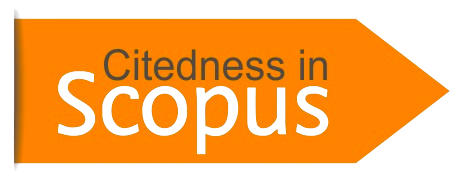Hubungan antara Kepribadian, Kesiapan Organisasi untuk Berubah dan Kriteria Universitas Kelas Dunia
DOI:
https://doi.org/10.15575/psy.v3i1.1098Keywords:
the big five personality, organizational change readiness, world class university.Abstract
Changes in the organization is important to retain its existence and continues to grow. This study attempted to see the connection between personality factors (the big five factor), organizational change readiness and the criteria of World Class University at University X. Based on the analysis of qualitative and statistical tests associated with the third link variable, then showed that the personality and organizational change readiness have an important role for the achievement of world class criteria university. This research showed that personality profiles of extraversion and openess to experience as well as aspects of the vision of change and acceptance phase to be decisive for the index of world class university. This result seems to be supported by the presence of the relationship between extraversion profile with aspects of the vision of change and acceptance. The profile of openness to experience also correlated with aspects of vision of change and acceptance.
References
Armenakis, A. A., & Bedeian, A. G. (1999). Organizational change: a review of theory and research in the 1990s. Journal of Management, 25(3), 293-315
Barrick, M. R., & Mount, M. K. (1991). The big five personality dimension and job performance: A meta-analysis. Personnel Psychology, 44
Bouckenooghe, D. & Devos, G. (2007). Psychological Change climate as a catalyst of readiness for change: a dominance analysis. Departement of Management and Entrepreneurship Ghent University
Bouckenooghe, D., Buelens, M. & Devos, G. (2007). Contribution of content, context, and process to understanding openness to organizational change: two experimental simulation studies. The Journal of Social Psychology, 147(6), 607-629
Brown, C., & Cregan, C. (2008). Organizational change cynicism: The role of employee involvement. Human Resource Management, Winter, 47(4), 667-686
DeYoung, C. G, (2010). Toward a theory of the big five. Psychological Inquiry, 21, 26-33
Elias, S. M. (2009). Employee commitment in time of change: assessing the importance of attitudes toward organizational Change. Journal of Management, 35(1), 37-55
Ivancevich, G., & Konopaske, D., (2006). Organization: Behavior, structure, processes. , New York: McGraw-Hill Internasional Edition
Judge, T. A., Higgins, C.A., Thoresen, C.J., & Barrick, M.R. (1999). The big five personality traits, general mental ability, and career success across the life span. Personnel Psychology, 52
Judge, T. A., Illies, R. (2002). Relationship of personality to performance motivation: A meta-analytic review. Journal of Applied Psychology, 87(4), 797- 807
John. O. P., & Srivastava, S. (1999). The Big-Five Trait Taxonomy: History, Measurement, and Theoretical Perspectives (2nd ed.) Handbook of personality: Theory and research
Kreitner, R. & Kinicki, A. (2007). Organizational Behavior (7th ed.). New York: McGraw-Hill
Korbangyang, S., & Ussahawanitchakit, P., (2009). Change readiness and performance of health care service business in thailand: mediator role of service excellence, resource exploitation and business competitiveness. International Business Research, 9(5)
Levin, H. M., Jeong, D. W., & Ou, D. (March, 2006). What is World Class University?. Conference of the Comparative & International Education Society, Honolulu
Martin, A. J., Jones, E. S., & Callan, V. J. (2005). The role of psychological climate in facilitating employee adjustment during organizational change. European Journal of Work and Organizational Psychology, 14(3), 263-289
Major, D. A., Turner, J. E., & Fletcher, T. D. (2006). Linking proactive personality and the big ive to motivation to learn and development activity. Journal of Applied Psychology, 91(4), 927-935
Rafferty, A. E., & Griffin, M. A. (2006). Perceptions of organizational change: a stress and coping perspective. Journal of Applied Psychology, 91(5), 1154-1162
Robins, S. P. & Judge, T. A. (2007). Organizational behavior (12th ed). Singapore: Pearson International Edition
Roccas, S., Sagiv, L., & Schwartz, S. H. (2010). The big five personality factors and personal values. Personality and Social Psychology Bulletin, 28(6), 789-801
Smith, I. (2005). Achieving readiness for organizational change. Library Management, 26(6/7), 408.
Sutanto, A. B. (2008). Organizational readiness for change: A case study on change readiness in manufacturing company in indonesia. International Journal of Management Perspective
Vakola, M., Tsaousis, I., & Nikolaou, I. (2003). The role of emotional intellegence & personality variables on attitude toward organizational change. Journal of Managerial Psychology
Vakola, M., & Nikolaou, I., (2005). Attitudes towards organizational change : what is the role of employees’ stress and commitment? Employee Relation, 27(2), 160-174.
Walker, J. H., Armenakis, A. A., & Bernerth, J. B. (2007). Factors influencing organizational change efforts An integrative investigation of change content, context, process and individual differences. Journal of Organizational Change Management
Weiner, B. J. (2009). A Theory of Organizational readiness for change. Departement of Health Policy and Management, Gillings School of Global Public Health, University of North Carolina Chapel Hill, North Carolina, USA. Diakses dari http://www.implementationscience.com/content/4/1/67
Downloads
Published
Issue
Section
Citation Check
License
The author whose published manuscript approved the following provisions:
1. The right of publication of all material published in the journal / published on the E-Journal of Psychology website is held by the editorial board with the knowledge of the author (moral right remains the author of the script).
2. The formal legal provisions for access to digital articles of this electronic journal are subject to the terms of the Creative Commons Attribution-ShareAlike license (CC BY-SA), which means that the Journal of Psychology reserves the right to save, transmit media / format, manage in database form, , maintain, and publish articles without requesting permission from the Author as long as it continues to include the name of the Author as the owner of Copyright.
3. Printed and published print and electronic manuscripts are open access for any purposes. In addition to these objectives, the editorial board shall not be liable for violations of copyright law.
Â






